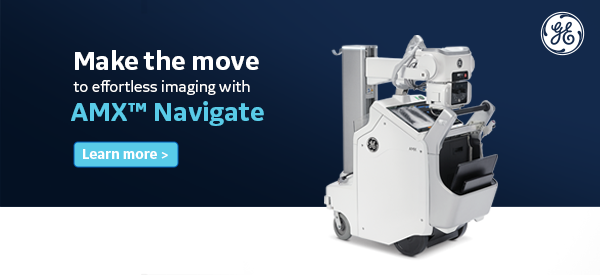To put it simply, X-ray will likely remain the mainstay modality in radiology for the foreseeable future. According to market research trend reports, the global X-ray market is estimated to grow at a 5.14 percent compound annual growth rate from a market size of $10.793 billion in 2019 to $14.580 billion by 2025.[1]
Drivers of that growth are threefold: the growing prevalence of certain diseases, the changing (and aging) dynamics of patient populations, and the impressive caliber of X-ray technologies fueling early diagnosis.[2] And the trends of each indicate that X-ray isn’t going anywhere anytime soon. The increased dependence on mobile X-ray systems during the global pandemic further supports those figures.
Growing prevalence of certain diseases spurs continued reliance on X-ray imaging
Report authors cite the increase in dental, cardiovascular, and orthopedic disorders as the top force behind X-ray’s continued growth.2 Given the statistics linked with each, it’s no surprise.
Already the top cause of mortality in the United States, heart disease deaths increased by 4.8 percent in 2020, the largest increase in heart disease deaths since 2012,[3] and its prevalence continues to trend upward.[4] Since many physicians first turn to chest X-rays to diagnose heart disease,5 the growth of the disease runs parallel to the growth of the technology to identify it.
The COVID-19 pandemic also significantly affected mortality rates across the globe, and according to provisional estimates from the National Center for Health Statistics (NCHS) National Vital Statistics System (NVSS), followed heart disease and cancer as the third leading cause of death in the US in 2020.3
Oral health disorders also feed into the continuing need for dental X-ray technologies, due in part to changing diets that include eating and drinking sugary treats.6 Because increased glucose from having diabetes can also lead to poor oral health,7 those needs continue to be an issue. The International Diabetes Federation reports that in 2019, approximately 463 million adults (20-79 years) were living with diabetes and by 2045 this will rise to 700 million.[5]
For orthopedics, experts point to growth in bone disorders like osteoporosis that also shows no sign of slowing down. Because of the aging population and longer life span, osteoporosis is increasingly becoming a global epidemic. The International Osteoporosis Foundation estimates that more than 200 million people are suffering from osteoporosis. According to recent worldwide statistics, 1 in 3 women over the age of 50 years and 1 in 5 men will experience osteoporotic fractures in their lifetime.[6] And while aging populations fuel growth in the use of X-ray, obesity also has an effect, as one Becker’s Spine Review author writes. This all amounts to the “perfect storm” of bone problems that need X-rays for accurate diagnosis: People are getting older while making their aging joints and bones carry around excessive weight.[7]
An aging population with a need for better healthcare
A growing geriatric population makes up another big driver. As people are living longer, the elderly population requires better healthcare access where better diagnostic and treatment measures can be offered. Many people in this category are either suffering from age-associated chronic diseases or are suffering from diseases due to unhealthy lifestyles. Advanced care is required to prevent further spreading of age-associated or degenerative diseases, such as osteoporosis.
On the orthopedic front, elder patients’ decreased ability to get around safely—paired with the general fragility that comes with aging—plays a role. Nearly 75 percent of hip, spine, and distal forearm fractures occur among patients 65 years old or over.[8]
Age is also a risk factor for poor oral health, but for different reasons. Generations that have grown up without fluoride toothpaste or fluoridated drinking water, for example, disproportionally have oral diseases—and about 1 in 4 people over 60 no longer have teeth of their own.[9]
Both trends feed into the growing need for elder population care—and X-rays, in particular, are major characters within that growth narrative.
Advancements in X-ray technology support continued utilization
Innovation that has widely eclipsed other dated technologies has also helped digitize and mobilize X-ray technologies, furthering its growth. As a result of advancements in the way of safety, effectiveness, and ease-of-use, X-rays continue to be widely used.
For starters, while stationary technology holds a majority market share of all X-ray technologies, portable solutions that can be used anywhere at anytime—like GE Healthcare’s mobile radiography systems[10]—are quickly becoming more relevant and clinically necessary. So much so that one report posits that by 2022, portable X-rays will even outpace stationary equipment.[11]
But it’s not just about evolutions in the scanner itself—the output of data has had (and will continue to have) its own renaissance of advancements.
Take GE Healthcare’s X-ray Quality Application* as an example. The platform digitizes reject data, such as images rejected due to poor image quality or patient positioning. Instead of needing to manually sort through that info, the platform auto-sends clinical leadership key information so that they can pinpoint major contributors and trends linked to their reject rates—and fix them to help save time and money.
Likewise, technologies like Critical Care Suite* digitize and automate once-analog processes by helping flag critical conditions to radiologists at the point-of-care.[12]
Both the X-ray Quality Application and Critical Care Suite involve artificial intelligence (AI), which has transformed imaging as a whole by complementing human clinical smarts with algorithmic precision.[13]
What do the trends mean for X-ray and healthcare?
These current trends not only highlight the evolution of X-ray technologies specifically, they also underscore the undercurrent of healthcare’s changing landscape overall. Patient populations are changing, along with epidemiology-related insights about disease prevalence.
To keep up, technology must evolve or get left behind. X-ray, which has been around for more than a century, is a classic example of that mantra. And true, while other imaging modalities like magnetic resonance imaging and ultrasound have their own applications, they don’t negate the need for X-ray. The COVID-19 pandemic is certainly a testament to that. And as long as diseases need diagnosing and people get older, X-ray still has its place when making clinical decisions. Whether it’s to identify hip fractures, diagnose heart disease, or find a dental cavity, X-ray’s ability to peer inside the human body is unmatched.
Learn more about GE Healthcare X-ray solutions, here.
* Not all products or features are available in all geographies. Check with your local GE Healthcare representative for availability in your country.
[1] https://www.itnonline.com/content/global-X-ray-device-market-expected-grow-4580-billion-2025
[2] X-ray Market will Exhibit a 4.5% CAGR From 2014 to 2022. CMFE News. https://cmfenews.com/X-ray-market-will-exhibit-a-4-5-cagr-from-2014-to-2022/. Accessed Dec. 11, 2018.
[3] Ahmad FB, Anderson RN. The Leading Causes of Death in the US for 2020. JAMA. 2021;325(18):1829–1830. doi:10.1001/jama.2021.5469. https://jamanetwork.com/journals/jama/fullarticle/2778234.
[4] Deaths from cardiovascular disease increase globally while mortality rates decrease. Institute for Health Metrics and Evaluation. http://www.healthdata.org/news-release/deaths-cardiovascular-disease-increase-globally-while-mortality-rates-decrease. Accessed Dec. 11, 2018
[5] https://idf.org/aboutdiabetes/what-is-diabetes/facts-figures.html
[6] Sözen T, Özışık L, Başaran NÇ. An overview and management of osteoporosis. Eur J Rheumatol. 2017;4(1):46-56. doi:10.5152/eurjrheum.2016.048
[7] Five trends that every orthopedic professional should watch in 2017. Becker’s Spine Review. https://www.beckersspine.com/orthopedic-spine-practices-improving-profits/item/35272-five-trends-that-every-orthopedic-professional-should-watch-in-2017.html.
[8] https://www.osteoporosis.foundation/facts-statistics/epidemiology-of-osteoporosis-and-fragility-fractures
[9] Oral Health for Older Americans. Centers for Disease Control and Prevention. https://www.cdc.gov/oralhealth/publications/factsheets/adult_oral_health/adult_older.htm. Accessed Dec. 11, 2018.
[10] Mobile X-ray Systems. GE Healthcare. https://www.gehealthcare.com/en/products/radiography/mobile-xray-systems. Accessed Dec. 11, 2018.
[11] X-ray Market (Product Type: Stationary & Portable (Mobile & Handheld); Technology: Analog & Digital (Computed Radiography & Direct Digital Radiography); Applications: Cardiovascular, Respiratory, Dental, Mammography & Others): Global Industry Analysis, Size, Share, Growth, Trends and Forecast 2014 - 2022. Transparency Market Research. https://www.transparencymarketresearch.com/X-ray-market.html. Accessed Dec. 11, 2018.
[12] AI-embedded X-ray system could help speed up detection of a collapsed lung. GE Healthcare. http://newsroom.gehealthcare.com/ai-embedded-X-ray-system-could-help-speed-up-detection-of-a-collapsed-lung/. Accessed Dec. 11, 2018.
[13] The Future of Radiology and Artificial Intelligence. GE Healthcare. https://medicalfuturist.com/the-future-of-radiology-and-ai. Accessed Dec. 11, 2018.


